A couple of years ago, when talking about bots, people would have easily given you either a questioning side-eye or a pitiful look. Bots have long had a bad rep in the general public.
The naughty list includes click bots that mess with your pay-per-click (PPC) campaigns, imposter bots that launch denial of service attacks, scraper bots that steal your meticulously crafted content, spam bots that keep pestering you with unwarranted emails or form submission and social media bots that spread noise and the proverbial ‘fake news’.
Scared yet?
Don’t be. The image and utility of bots have changed over the past years, as legit companies are discovering chatbots as a
“Primary gateway and channel between businesses and shoppers.”
(Microsoft chief executive Satya Nadella).
In fact, 80% of companies plan to implement chatbots by 2020.
Today, chatbots play a role in many business functions, including marketing, eCommerce and customer service, the latter of which has the potential to produce $23 billion in savings.
These specialized customer service chatbots provide consumers with an interactive, convenient and quick way to communicate with your business. They can handle inquiries and support consumers, eliminating the frustrations associated with waiting in line or being put on hold.
So how can your business take advantage of this emerging technology?
This quick and immediate way of handling customer service requests through chatbots can certainly help
- improve customer satisfaction and NPS (Net Promoter Score)
- free up your live agents to handle more difficult requests that require human assistance
- reduce operating costs (by up to 30%!)
- scale the increasing volume of customer conversations
Clearly, the ROI impact of customer service chatbots is significant.
But before you jump in, know that chatbots are not a quick, catch-all fix. They do not remedy your current user experience or customer service problems, but rather, add a new dimension.
Customer Service Chatbots – Do’s and Don’t
DO’s
Do map out a strategic plan before developing your chatbots beyond merely choosing a chatbot type and platform. What are your business objectives? What functions will your chatbot support? What issues will they solve? What needs do your users have? Shortcutting the what’s, why’s and how’s will not be efficient in the long-run. Defining your purpose thoroughly will ensure your business and users both benefit optimally.
Do personify your chatbot! Give it a name and personality; it will be more engaging, memorable and impactful than a generic bot. Approach your chatbot like you are creating a movie or novel. Brainstorming characteristics and attributes will help your chatbot come to life. Does your company have a mascot you can channel for inspiration? Choose a tone: practical, funny, know-it-all? Will your chatbot be entertaining? Talk in first or third person?
Do also learn from bad examples. In 2016, Starbucks created a character The Real PSL (Pumpkin Spiced Latte). The sunglasses-wearing bot answered questions in a snarky way and responded with one-liners. Left to say, people didn’t like it. It was not helpful with basic tasks and would deflect questions that it could not answer.
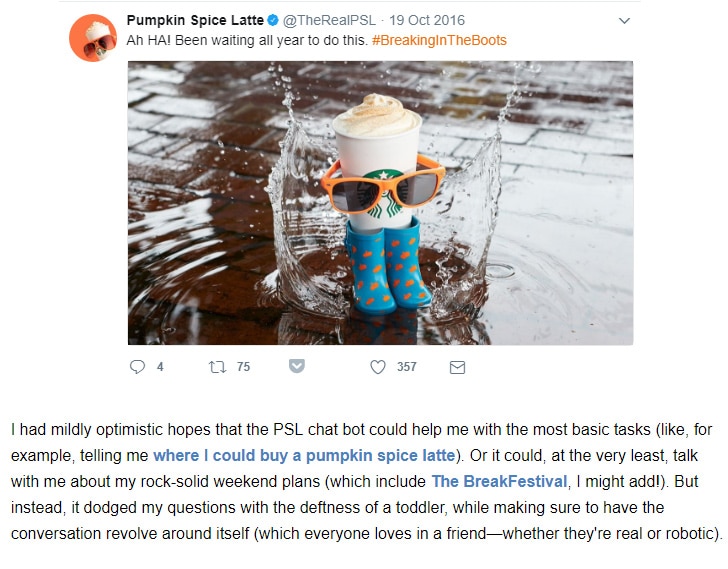
Review on ExtraCrispy – “The Starbucks Pumpkin Spice Latte Chat Bot Is Nightmare Fuel”
If you want to deploy chatbots effectively, you should keep an eye on utility. A cute character with personality will undoubtedly get your customer’s attention, but it’s its usefulness that will decide whether your chatbot will gain traction or not. Globally, 48% of respondents said they preferred a chatbot that solved their issue over a chatbot that had a personality.
Do be conversational to connect with your audience. The intersection of increasing mobile messaging app usage and advancements in AI has led to the rise of conversational commerce. It gives you a unique opportunity to enhance your brand appeal and voice. Don’t make your bot sound like… a bot. Remember there are many routes to accomplish every task. Design multiple conversation flows to provide “unique and complete experiences” to users.
Do guide users to accomplish specific tasks. Prompt customers with possible suggestions and context-based help cards for easy and intuitive access. It is also beneficial to provide a direct link to human assistance within the platform. Forcing users to exit the screen and hunt around by themselves defeats the purpose of customer service chatbots and causes additional friction.
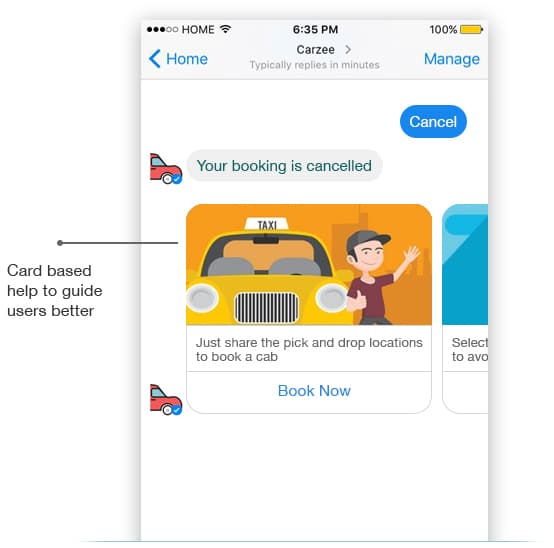
Source: Chatbots Magazine
Do evaluate analytics. Monitor
- active rate (number of active sessions of a user / total number of sessions of that user),
- engaged rate (number of engaged sessions of a user / total sessions of that user),
- confusion triggers (when chatbot says “I don’t understand”),
- conversation steps (single back-and-forth exchange between a user and a bot),
- average number of conversations/user
- and retention (one day, seven days, 30 days).
You can utilize analytics platforms such as Dashbot, Botanalytics, Facebook Analytics and BotMetrics. Discovering your active users and peak conversation times will lead to improvement opportunities.
DON’TS
Don’t forget to test. Several tools exist to beta test your chatbots with a smaller user group before launch to identify problems before they affect your customers. Capture what is confusing users, whether users are interacting the way you expected and how the conversation ends. A typical process is to test in front of one sub-group, make changes and test again with a second sub-group. The closer you can align the demographics of your sub-group to your actual user base, the more effective your testing will be.
Don’t nix all of your human agents. A customer contact may escalate beyond the chatbot due to a misunderstanding or frustration. Companies may still prefer to resolve complex issues or close high-value transactions through human agents. The aim is to reduce the number of repetitive tasks that involve your live agents, not necessarily eliminate all of them 100% of the time.
Don’t neglect to promote your chatbots. For example, implement a campaign via email marketing, website banners, social media and public relations. Don’t quit your efforts after launch either; a continuous marketing campaign is necessary to maintain active users. Don’t forget that your live agents are also essential to spreading the word (“Have you tried out our new chatbots?”).
Don’t overpromise. Customer service chatbots are still in the early stages of debut. As a result, “AI technologies are not as developed within customer service to ensure that this process is seamless.” There will errors and misunderstandings, so businesses and customers alike will require patience. Machine learning also enhances the experience over time as chatbots grasp intentions and build on previous interactions.
Don’t stop iterating. As you review analytics and listen to customer feedback, you will identify how to revise your chatbot capabilities for optimal performance. There will always be ways to tweak conversation flows, increase interactivity and enhance personalization. Stay tuned to the new waves of best practices that are currently being fleshed out; for instance, Google has taken on research to explore how to make AI more useful, which will lead to more tools and resources for developers. Similar to any technological initiative, stay tuned to industry research, analyze your data, listen to customers and adapt.
Chatbot Classification – Which one to go for?
Chatbots are usually categorized based on the conversation capability and response mechanism as described in the graphic below.
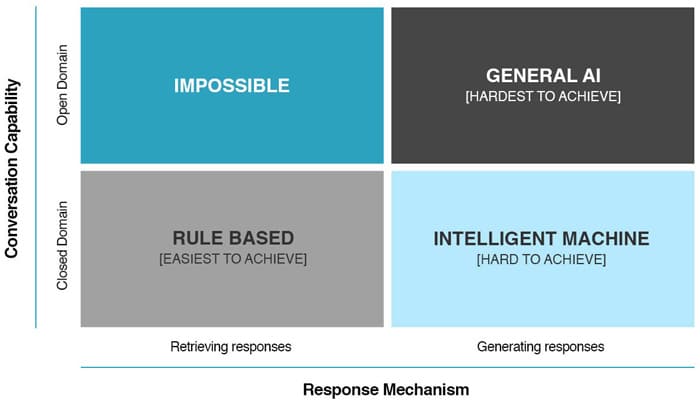
Conversation capability defines whether the chatbot can provide meaningful responses in an open domain or if it is only able to steer the conversation in a predefined topic area (closed domain).
Response mechanism refers to the chatbot’s ability to either retrieve responses (e.g. from a database) or create new responses on the fly.
To better understand how chatbots work and to choose the best option to invest in to see maximum rewards, you should know that there are two types of chatbots: chatbots based on rules, and chatbots based on artificial intelligence (AI).
Types of Chatbots
1. Rule-based Chatbots
Rule-based bots are simple but effective. Like a push button, they use a set of rules to trigger actions for a pre-defined set of options. When the user says “A” it will respond with “B” only if there is a rule defined for this scenario.
While they are relatively straightforward, they can’t understand user inputs that they have not been trained on. A rule-based bot is only as smart as it was programmed to be.
This rule-based approach works well if you need your chatbot only to execute on very specific commands, such as creating a calendar event, booking a flight, displaying information, etc.
Now, if you want to stimulate a conversation, conversational bots are the more advanced version of rule-based bots. They add chat capabilities to your rule-based bot and usually reside on social media platforms and community-oriented websites, such as Facebook, where your audience can easily find them.
These conversational chatbots are equipped to deliver one-dimensional linear customer service and are comparatively inexpensive to build.
Example: Madi, Madison Reed’s chatbot on Facebook Messenger
It assists customers in choosing the right hair color shade by analyzing a current picture along with the customer’s preferences.
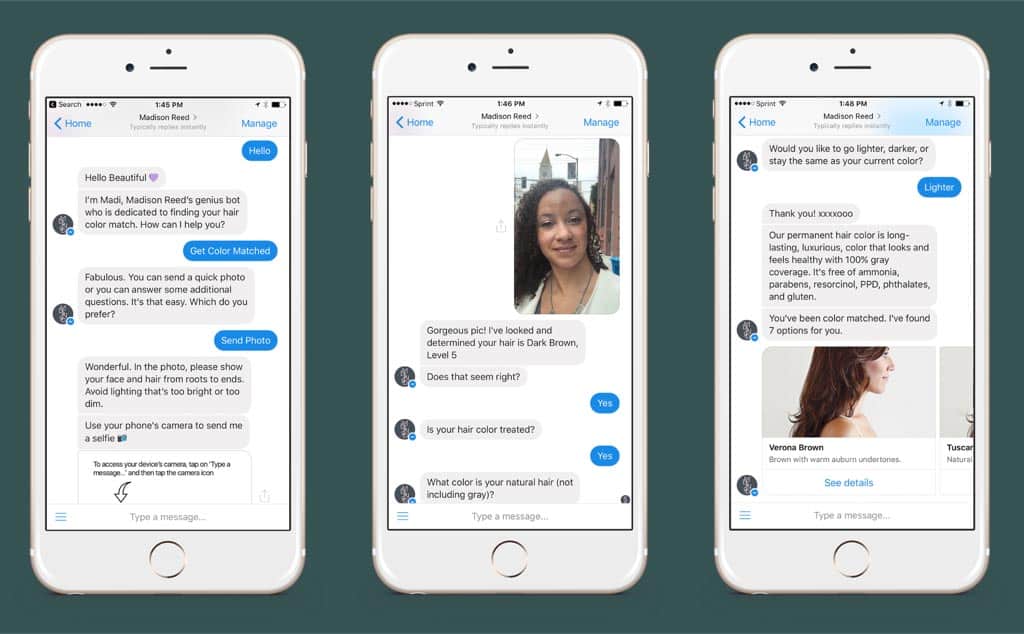
Madison Reed Hair-Color Chatbot on Facebook Messenger – Image by WWD
If you want to start out with a smaller investment, a rule-based chatbot will sufficiently help you tackle a surmounting amount of customer inquiries.
There are several self-service chatbot platforms and hosting services to build a bot yourself and integrate it on messenger platforms. The Chatbots Journal compiled 25 chatbot platforms in a comprehensive, comparative table. Here are the most popular:
With SMARTASSISTANT, you can turn your digital advisors into chatbots.
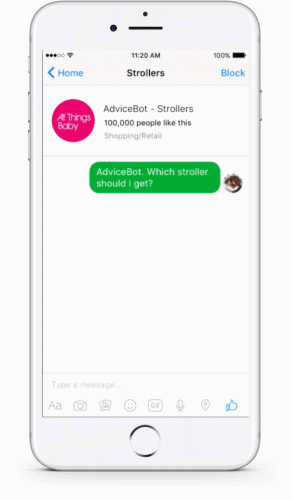
SMARTASSISTANT Chatbot – Stroller Advicebot
2. AI-based Chatbots
Chatbots fueled by AI go further than rule-based chatbots due to two hallmarks: natural language processing and machine learning.
These bots can comprehend the intent, meaning, and context of what the user is saying. They also get smarter with time as they utilize deep (unsupervised) learning methods. These intelligent systems, which are categorized as smart machines, can learn from conversations and information gathered to use the newly acquired knowledge to make future decisions.
If you want your chatbot to work in an open domain and understand natural language, you should look into AI bots. It means teaching the bot with algorithms to provide answers to questions intelligently.
Example: LoweBot is Lowe’s autonomous retail service robot
It was introduced in Lowe’s Stores throughout the San Francisco Bay area in 2016. LoweBot uses natural-language processing to reply to questions in multiple languages. Customers can ask questions like, “Where’s the paint” and it will help them effectively navigate the store. What’s more is that it can detect a person standing idly in a section, probably in need of help, and will engage and initiate a conversation. It’s learning from its interactions in real-time and generates stats that determine sales patterns.
AI bots are more expensive and difficult to implement and have not seen the commercial success in the same manner as rule-based bots.
If you want to craft your AI-powered chatbot yourself, you need a development team with natural language processing (NLP) skills. While there are tools for NLP such as Opennlp and Nltk to accelerate development, the costs for a custom chatbot can range from anywhere between $6,000 and $13,000.
In the advent of virtual assistants, research is moving quickly, so we haven’t seen all of it just yet.
The landscape for customer service chatbots is certainly wide with varying terrain. Although the industry is trending towards higher levels of intelligence and personalization, it’s important to survey your needs critically to determine which route is best for your business and customers. Fortunately, what’s best for your customers typically results in the best for your business.


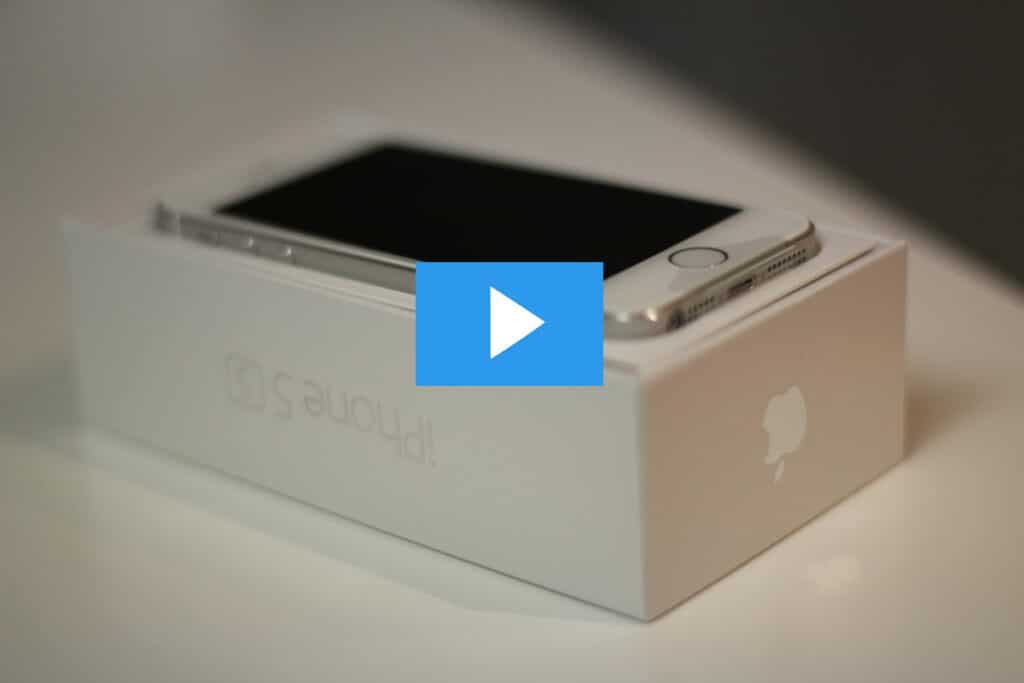
![How Virtual and Augmented Reality will Influence Decision-Making [Infographic] | Guided Selling](https://www.guided-selling.org/wp-content/uploads/2016/06/generate_images_for_my_blog_post_post_title_is_-6.jpg)
